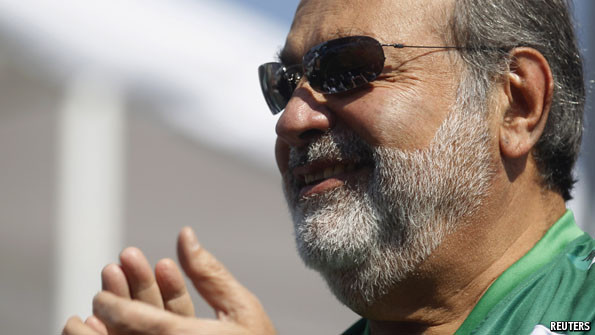
Plutocrats and their progeny
A secretive fathers-and-sons knees-up for billionaires
May 1, 2013 - Economist
AS THE workers of Latin America celebrated May Day, a select handful of the capitalist class was getting ready for an exclusive shindig of its own. The Father and Son Business Meeting, an annual get-together for plutocrats and their progeny started by Carlos Slim (pictured), the richest of them all, was due to get under way on May 1st in Lima.
The guest list of the event is always a closely guarded secret. Staff at the hotels where it is held sign confidentially waivers. But it has emerged that Tony Blair, who has discovered an entrepreneurial streak as a speaker since leaving Downing Street, will deliver this year's keynote address. The food is being laid on by Gastón Acurio, a Peruvian chef whose restaurant was recently voted one of the world's best. Seminars on the state of Latin America's economy are expected.
The idea behind the ten-year-old gathering is to give Latin America's leading empresarios the chance to hobnob without pressure from the media or lobbyists. It is also a chance for the next generation of billionaires to get to know each other. Sons and the odd nephew are invited to the do. Women do not seem to appear on the few past guest-lists that have been made public.
The past two meetings, held in Mexico in 2011 and in Argentina last year, included sessions on the role of business in national development, the outlook for young people, how to finance investment and best practices for taking regional companies global. Guest speakers tend to include the host country's president (although Cristina Fernández, Argentina's premier, did not attend in 2012), as well as intellectuals and finance gurus.
Carlos Rodríguez Pastor, Peru's second-wealthiest man with an estimated fortune of $3.4 billion, is organising this year's event. He says that it is merely "a chance for friends to get together and share ideas," adding mysteriously: "There is nothing mysterious about it."
Mysterious or not, the event highlights some of the changes that have taken place in the region and among its plutocrats since 2003, when the first knees-up took place. Then there were no Latin Americans in the top 10 of the annual billionaire-list compiled by Forbes. Mr Slim was 35th. Now he is in first place. In all, six Latin Americans are in the top 50: they comprise three Mexicans (including Mr Slim), two Brazilians and a Chilean. Their combined wealth is $159 billion.
How they came by their fortunes might be surprising. Lately Latin America has benefited from a commodity boom, particularly in mining, oil and gas. But the largest number of fortunes has come from serving the burgeoning middle class. Among the 40 richest Latin Americans, the largest number have fortunes based on drinks (nine) and retail (six). Peru's richest man, Eduardo Belmont (who has a fortune of $6.1 billion), got wealthy selling cosmetics. Mr Slim, whose fortune is estimated to be around $73 billion, made his money with a near monopoly on telephony and internet in Mexico.
Since the plutocrats' parties began a decade ago, millions more Latin American families have moved into the middle class. The World Bank estimates that the region's middle class now represents the same number of people who are poor. Inequality, however, remains among the steepest in the world—something that Mr Blair and the billionaires might find time to discuss as they crack open the champagne on May Day.